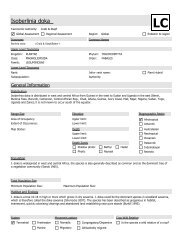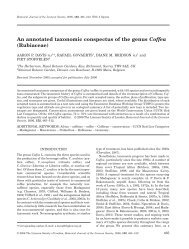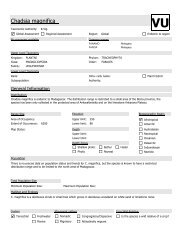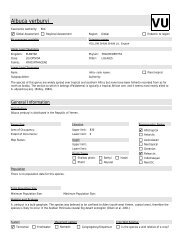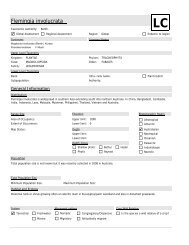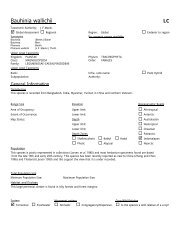Dalbergia assamica - Sampled Red List Index for Plants
Dalbergia assamica - Sampled Red List Index for Plants
Dalbergia assamica - Sampled Red List Index for Plants
Create successful ePaper yourself
Turn your PDF publications into a flip-book with our unique Google optimized e-Paper software.
<strong>Dalbergia</strong> <strong>assamica</strong><br />
Taxonomic Authority: Benth<br />
Global Assessment Regional Region: Global Endemic to region<br />
Synonyms<br />
<strong>Dalbergia</strong> balansae Prain<br />
<strong>Dalbergia</strong> lanceolaria Benth<br />
No common names available<br />
Upper Level Taxonomy<br />
Kingdom: PLANTAE<br />
Phylum: TRACHEOPHYTA<br />
Class: MAGNOLIOPSIDA Order: FABALES<br />
Family: LEGUMINOSAE<br />
Lower Level Taxonomy<br />
Rank: Infra- rank name: Plant Hybrid<br />
Subpopulation:<br />
Authority:<br />
The taxonomic status of this species is debated. Some still recognise <strong>Dalbergia</strong> balansae as a separate species but<br />
others have it as a synonym, with the accepted name <strong>Dalbergia</strong> <strong>assamica</strong> Benth. It is assessed here under<br />
D.<strong>assamica</strong> following Niyomdham et al. 1997.<br />
LC<br />
General In<strong>for</strong>mation<br />
Distribution<br />
This species is found in northern Viet-Nam and southern China, Laos, Cambodia,Thailand, Myanmar, Bangladesh and India,<br />
and has been introduced into tropical Africa.<br />
Range Size Elevation Biogeographic Realm<br />
Area of Occupancy: Upper limit: 800 Afrotropical<br />
Extent of Occurrence: Lower limit: 50 Antarctic<br />
Map Status: Depth Australasian<br />
Upper limit:<br />
Neotropical<br />
Lower limit:<br />
Oceanian<br />
Depth Zones<br />
Palearctic<br />
Shallow photic Bathyl Hadal Indomalayan<br />
Photic Abyssal Nearctic<br />
Population<br />
There are recent collections <strong>for</strong> this species, it has a wide distribution and occurs in a variety of habitats. It can tolerate<br />
some disturbance and natural regeneration is strong on abandoned shifting cultivation areas (Chinh et al 1996). The<br />
population is, there<strong>for</strong>e, inferred to be large and stable.<br />
Total Population Size<br />
Minimum Population Size:<br />
Maximum Population Size:<br />
Habitat and Ecology<br />
This species grows in lowland and submontane mixed deciduous and dry evergreen <strong>for</strong>est, scrub and wasteland around<br />
villages. Natural regeneration is strong on abandoned shifting cultivation areas (Chinh et al 1996).
System Movement pattern Crop Wild Relative<br />
Terrestrial Freshwater Nomadic Congregatory/Dispersive Is the species a wild relative of a crop<br />
Marine Migratory Altitudinally migrant<br />
Growth From<br />
Tree - size unknown<br />
Definition<br />
Tree (any size), also termed a Phanerophyte (>1m)<br />
Threats<br />
This <strong>for</strong>est tree suffers from the general threats associated with increasing human population pressure upon <strong>for</strong>ested areas,<br />
mainly clearance <strong>for</strong> timber and <strong>for</strong> agricultural purposes.<br />
Past Present Future<br />
1 Habitat Loss/Degradation (human induced) <br />
1.1 Agriculture <br />
1.3 Extraction <br />
1.3.3 Wood <br />
1.3.3.3 Clear-cutting <br />
Conservation Measures<br />
There are no specific conservation measures in place <strong>for</strong> this widespread species. It is found in existing protected areas, <strong>for</strong><br />
example, it is listed as a major tree of the mixed <strong>for</strong>est in Mae Ngao National Park in Thailand. This species is cultivated<br />
ex situ and seed is available from seed catalogues. Further research may be needed to clarify the taxonomy of this<br />
In Place Needed<br />
3 Research actions <br />
3.1 Taxonomy <br />
4 Habitat and site-based actions <br />
4.4 Protected areas <br />
5 Species-based actions <br />
5.7 Ex situ conservation actions <br />
5.7.1 Captive breeding/Artificial propagation <br />
Countries of Occurrence<br />
Year Breeding<br />
PRESENCE<br />
ORIGIN<br />
Non- Passage Possibly Extinct Presence Native Introduced Re- Vagrant Origin<br />
Round Season breeding migrant extinct uncertain Introduced uncertain<br />
only season only<br />
Bangladesh <br />
Cambodia <br />
China <br />
India <br />
Lao People's Democratic <br />
Republic<br />
Myanmar <br />
Thailand <br />
Viet Nam
General Habitats Score Description Major<br />
1 Forest 1 Suitable Unset<br />
1.5 Forest - Subtropical/Tropical Dry 1 Suitable Unset<br />
1.6 Forest - Subtropical/Tropical Moist Lowland 1 Suitable Unset<br />
3 Shrubland 1 Suitable Unset<br />
3.5 Shrubland - Subtropical/Tropical Dry 1 Suitable Unset<br />
3.6 Shrubland - Subtropical/Tropical Moist 1 Suitable Unset<br />
14 Artificial/Terrestrial 1 Suitable Unset<br />
14.5 Artificial/Terrestrial - Urban Areas 1 Suitable Unset<br />
Ecosystem Services<br />
Insufficient In<strong>for</strong>mation available<br />
Species provides no ecosystem services<br />
Species Utilisation<br />
Species is not utilised at all<br />
Purpose / Type of Use Subsistence National International<br />
16. Other <br />
9. Construction/structural materials <br />
This tree is grown to provide shade in tea gardens in Assam and is recommended as a mid-storey tree <strong>for</strong> shelter belts<br />
(Hanelt 2001). This tree, in Vietnam, is considered one of the best hosts <strong>for</strong> lac insects, from which a resin is extacted<br />
(Chinh et al 1996).<br />
Trend in the level of wild offtake/harvest in relation to total wild population numbers over the last five years:<br />
Trend in the amount of offtake/harvest produced through domestication/cultivation over the last five years:<br />
CITES Not listed<br />
IUCN <strong>Red</strong> <strong>List</strong>ing<br />
<strong>Red</strong> <strong>List</strong> Assessment: (using 2001 IUCN system) Least Concern (LC)<br />
<strong>Red</strong> <strong>List</strong> Criteria:<br />
Date Last Seen (only <strong>for</strong> EX, EW or Possibly EX<br />
Is the species Possibly Extinct Possibly Extinct Candidate <br />
Rationale <strong>for</strong> the <strong>Red</strong> <strong>List</strong> Assessment<br />
This species has an extent of occurrence (EOO) that greatly exceeds the critical threshold <strong>for</strong> a threatened category. The<br />
estimated area of occupancy (AOO) and inferred population also exceed the critical thresholds. It is assessed as Least<br />
Concern (LC). However, further research is needed to confirm the taxonomy, since D.balansae, if treated as a<br />
separate species, may have a different assessment category.<br />
Reason(s) <strong>for</strong> Change in <strong>Red</strong> <strong>List</strong> Category from the Previous Assessment:
Genuine Change Nongenuine Change No Change<br />
Genuine (recent)<br />
Genuine (since first assessment)<br />
New in<strong>for</strong>mation<br />
Knowledge of Criteria<br />
Taxonom<br />
Criteria<br />
Same category<br />
and criteria<br />
Incorrect data used Other Same category but<br />
Current Population Trend: Stable Date of Assessment: 29/07/2010<br />
Name(s) of the<br />
H.Chadburn<br />
Evaluator(s):<br />
Notes:<br />
% population decline in the past:<br />
Time period over which the past decline has been measured <strong>for</strong><br />
applying Criterion A or C1 (in years or generations):<br />
% population decline in the future:<br />
Time period over which the future decline has been measured<br />
<strong>for</strong> applying Criterion A or C1 (in years or generations):<br />
Number of Locations:<br />
Number of Mature Individuals:<br />
Severely <br />
Bibliography<br />
Chinh, N. N., et al., 1996, Vietnam Forest Trees, , Agricultural Publishing House, Hanoi<br />
Hanelt, P., 2001, Mansfelds encyclopedia of Agricultural and Horticultural Crops, Institute of Plant Genetics and Crop Plant<br />
Research, , Springer, Berlin<br />
Mae Ngao National Park Services., 2010, Mae Ngao National Park29 July, , Mae Ngao National Park,<br />
Niyomdham, C., 2002, An account of <strong>Dalbergia</strong> (Leguminosae-Papilionoideae) in Thailand, Thai Forest Bulletin, 124-165, ,<br />
Niyomdham, C., Ho, P.H., Dy Phon, P. and Vidal, J.E., 1997, Leguminoseae-Papilionoideae Dalbergieae, Flore du Cambodge<br />
du Laos et du Vietnam, Morat, Ph., , Museum National D'histoire Naturelle, Paris<br />
Thothathri, K., 1987, Taxonomic revision of the tribe Dalbergieae in the Indian subcontinent, , Botanical Survey of India,



